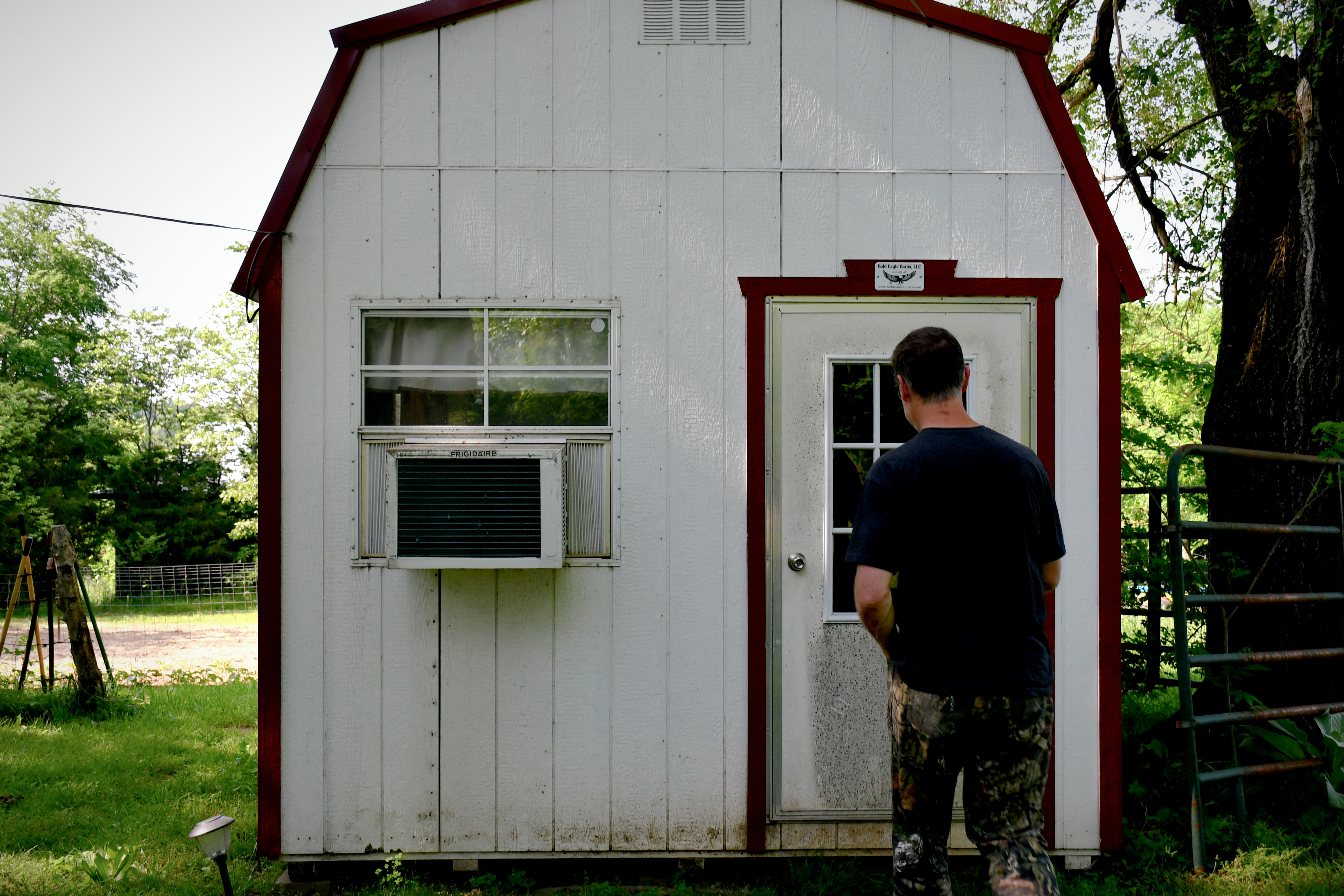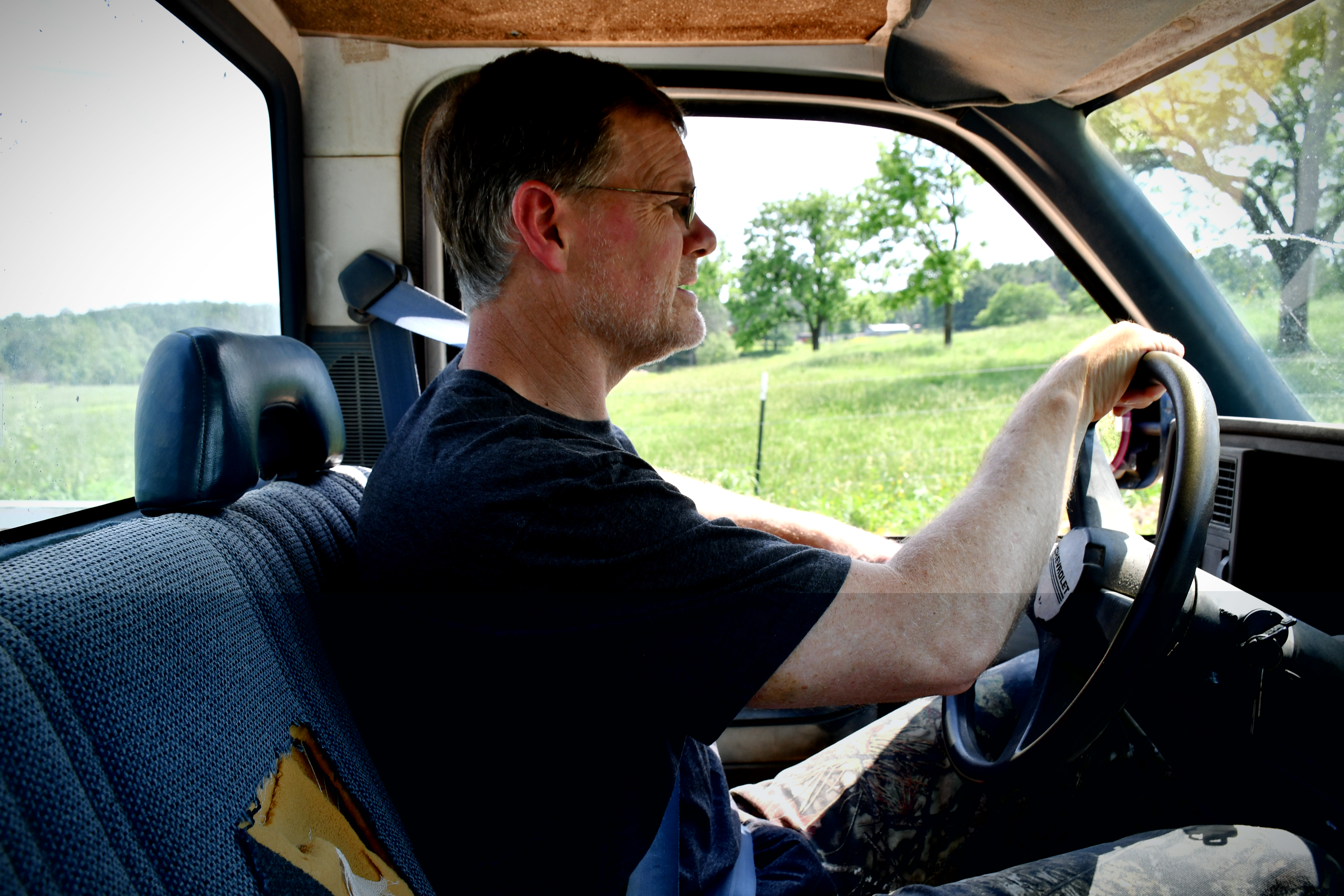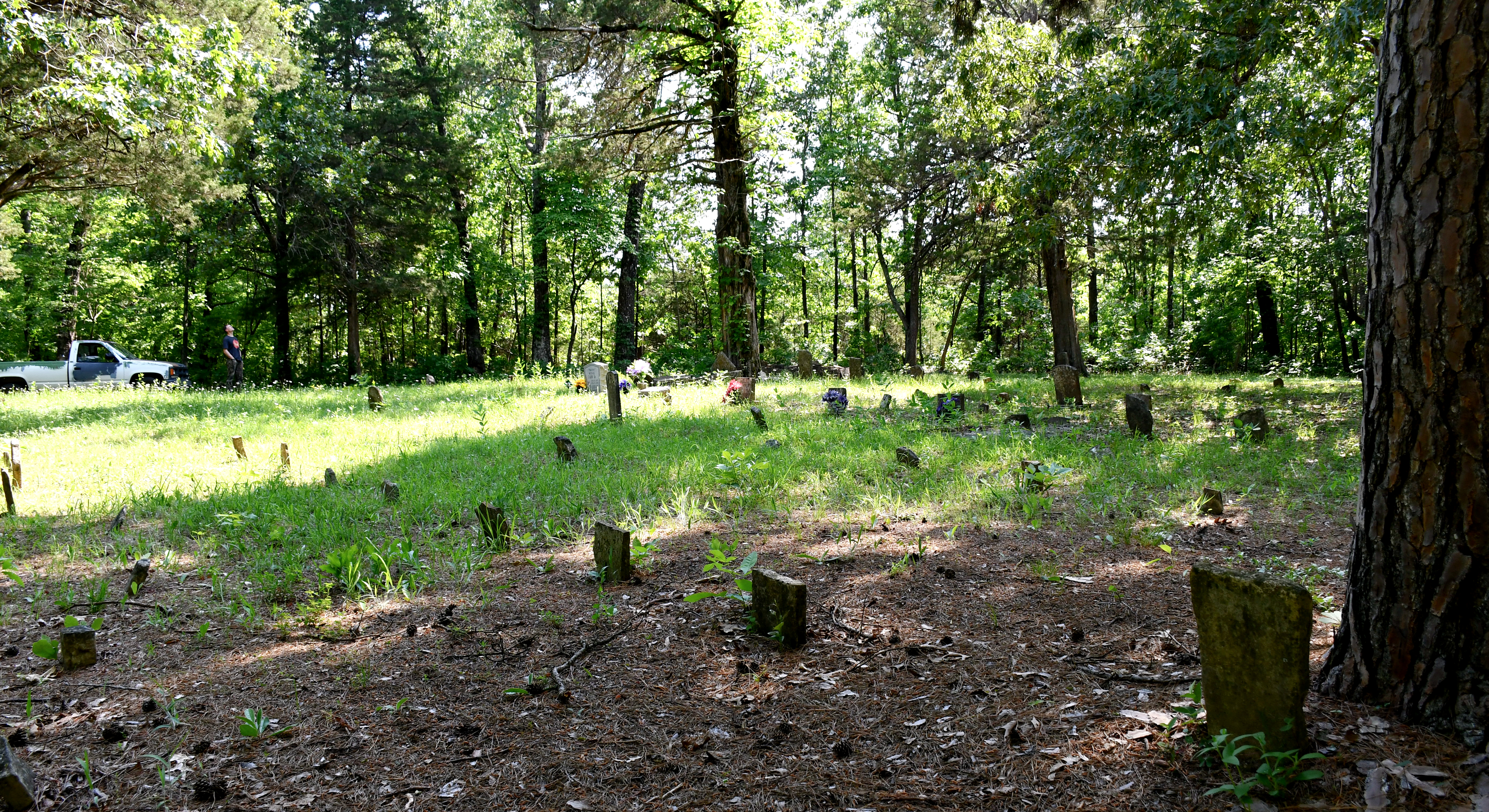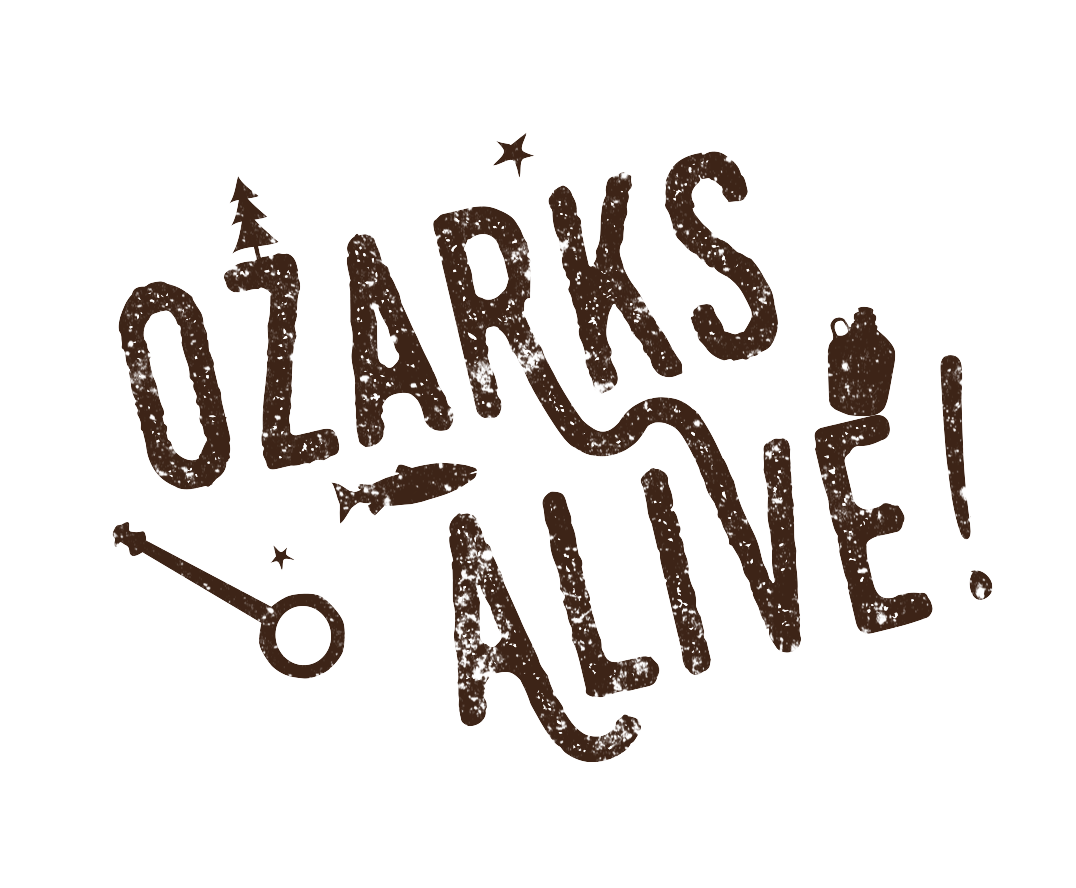This story is published in partnership with Ozarks Alive, a cultural preservation project led by Kaitlyn McConnell.
VIOLET HILL, ARK. - Aside from a store, a school and a historical marker a few miles from town, there’s little to see around Violet Hill, Ark., a place where purple flowers come forth each year to keep the town honest. But despite its not-always-great-for-growing shallow soil, it has the ability to seed deep roots when it matters — and to the region, it matters because it’s where a young Brooks Blevins first began pondering about an Ozarks past.
That child who looked at outhouses and wondered of their place in days before grew into the Ozarks’ preeminent historian whose spoken and written words have defined academic study of the region.
“I just remember everything about the past intrigued me,” says Blevins, now with “Dr.” in front of his name, of seeing old-time relics on the farm growing up. “The outhouse was interesting to me. I was interested in the stories that I heard my grandparents and the old-timers tell.
“You were just always reminded that there's some kind of continuum, and you're in it somewhere. And you might be in the middle of it, but you just don't know it yet.”
Those words are voiced inside a small white shed, reached by a cow-path-like trail worn in the grass, on a farm where his grandparents moved as tenant farmers in the 1930s. It’s also where he lives with his wife, Sharon, and where their two children spent most of their growing-up years.
Amid Christmas decorations, a bike — he rides every day — and books, a print of a barn hangs on the wall. It was the one that stood on the farm in his early life, when he lived a quarter-mile down the road from his grandparents. And its memory is a witness as he writes history into reality on the nearby computer.
“I've had the question before: ‘What do you think it was that made you a historian, or what got you interested?’ And I could say, ‘Well, it was growing up here, and growing up around all these relatives, and growing up on this old farm with all this stuff,’” says Blevins — but he has a brother who had the same experience and came away without inclination to make Ozarks history his livelihood.
“Some people are just, I think, kind of born historians. I don't know why. I mean, who knows how to explain what it is that we're attracted to?”
Understanding the Ozarks

The family story in Izard County goes back much deeper than the barn on the wall or the farm beneath the feet, as Blevins’ family has called the local hills home for around 200 years. By the time he came around in 1969, he was part of a place that had seen significant population shifts in the years prior — not unlike other parts of the Ozarks — leading to fewer people but a greater chance that you were kin to them.
“As I talked about in volume three (of the trilogy), there was an exodus of people in roughly the first 20 years after World War II,” says Blevins. “And Izard County was particularly hard hit, actually. I think out of all the counties in the Ozarks that had the highest population decline in the ‘50s, and ‘60s. And so when I was a kid, there weren't many people here, and almost all the people who were here were related to us.”
While most of those folks were seen at church and community gatherings and calendar milestones, he met others through a Blevins family history book, written by a distant cousin, that he read growing up.
“I remember being intrigued by that when I was a little kid reading it,” he recalls of the history book.
Blevins went through eighth grade at Violet Hill. When it was time for high school, he transferred to another around 25 miles away because his father, who was a basketball coach, got a new job. The move was fortuitous in other ways, as it’s where he met his future wife, who also has roots in the region.
The interest in history was still there in those years, but high school graduation didn’t launch him into the world with a mission of becoming an Ozarks historian. At the time, in fact, he didn’t even really realize that he was in the Ozarks himself.
“I didn't know I grew up in the Ozarks. I mean, nobody in our family ever used the ‘O’ word,” says Blevins. “We had the Ozark Folk Center across the river, over in the next county, so I knew that was the Ozarks over there. As hard as it is to believe, Springfield is where our TV came from; it wasn't real plain, but that's the TV that we got, and we're a long way from Springfield. And they were always Ozark this and Ozark that, and I thought, ‘Well, the Ozarks is in Springfield, somewhere up there.’”
It wasn’t until he was attending today’s Lyon College, a liberal arts institution around 40 miles away, that he had his first foray into regional history. In his junior year, he did a project on LaCrosse, a nearby defunct African-American settlement — where the aforementioned historical marker stands.
“I did a research project on that community, and that was kind of the first thing that convinced me that in many ways, history is local,” says Blevins.
The next year, a discussion with a professor who somehow ended up in rural Arkansas from Manhattan — New York, not Kansas — added another layer of understanding.
“I remember having a conversation with him. I don't remember really any of the details of that conversation. But I remember when I left his office that day, I just sort of knew that I wanted to study the Ozarks and that this was a legitimate thing to do,” recalls Blevins.
“I don't think at 22 I still had the capacity to think in terms of these big, lifetime career ideas. What I knew at that very moment was that someone who was a lot smarter than me, and who came from New York and who was educated to Harvard and Stanford, had basically told me that studying my home region was a legitimate option; that there was worth in that.”
The next chapters Blevins wrote in his own story were filled with graduate study at Auburn University in Alabama — where he went after receiving a graduate assistantship — and later he pursued his Ph.D.
After completing years of coursework, but before he finished his dissertation, he moved back to Arkansas. To research the Ozarks, it was easier to be home.
“I remember the last conversation I had with Dr. Flynt before I left,” says Blevins of the professor overseeing his studies. “It was unusual for an ABD (all but dissertation) student to just up and leave the institution and move 500 miles away. I remember he said, ‘If it was anybody else but you I would say, “It's been nice knowing you, you're not going to finish, and best of luck in life.”’ But he said, ‘I think you're gonna finish this thing.’”
And in 1999, he did. That dissertation work fueled “Hill Folks,” a book that gives a historical look at the Arkansas Ozarks, which was published in 2002.
“It took me longer than it probably should have,” says Blevins of completing his doctorate. “Because I got addicted to computer baseball.”
(Insert silence.)
“I wasted several months. I mean, I would occasionally do research. But mostly I was playing baseball on the computer — and having a great time. I mean, it was fun. Even today, you know, I think about how wonderful that was.”
Perhaps there are parallels: Blevins’ ability to play baseball without getting bored is similar to his capacity to seemingly tirelessly study Ozarks stories and history.
“I hope I'm just remembered as someone who cared enough about the region to tell these stories,” says Blevins, “and especially someone who tried to do it evenly and as objectively as possible, which is always what historians try to do or should try to do.”
The next few years saw Brooks teaching and working in different places: First a year in Mississippi, where academics may cringe to hear he taught seven new courses in one year. Then there was intermingling time at Ozarka College and Lyon College, both in Arkansas.
At the latter, his alma mater, he wrote a history of the institution and later served as Regional Studies Director and an assistant professor of history before a call came from Missouri State University — and a job offer as the first Noel Boyd Professor of Ozarks Studies.
Building on years of academic study of the Ozarks region, MSU’s website notes, the university created the professorship “to develop and teach a multidisciplinary array of courses.” He began in 2008, which led to the creation of a minor in Ozarks Studies in 2010.
“I guess in the back of my mind I'd always thought that might be a chance, but I wasn't interested in leaving here,” says Blevins of MSU, which is around three hours from his home in Izard County. “And it was only when I got multiple assurances that we could work out something to where I wouldn't have to move up there that we were able to do that.”
As with the history of life, that agreement has caused both good and, in a way, regret. Not for what he did, but for what he missed, especially with young children at home and his being gone multiple days and nights each week.
“We were sitting there and my daughter, who was probably about five years old at the time, said, ‘Daddy, what are you doing here?’” recalls Blevins of a moment during time away from college for break. “In a way, that made me feel good. Because they were kids, and they adjusted to my being away. But it also reminded me that life goes on whether you're around or not, even if you're gone part of the time.
“I certainly don't regret taking that job, (but) I had to spend way too much time away from my family those first few years.”
Writing the Ozarks

Along the way, he was writing. Over the last 20 years, he’s written or edited 11 books, covering history to mystery and murder. The most extensive work on the list to date wrapped up in late 2021, with the completion of “A History of the Ozarks,” the aforementioned trilogy that chronicles the region’s story from prehistoric to contemporary times.
As has been said, necessity is the mother of invention — and part of the idea for the project came about after Blevins found a need for a comprehensive history of the region to use in his classes.
“There just wasn't that,” he says. “I would assign a couple of books and sometimes change them up from year to year, and just kind of use what little was out there. So really, it was just kind of when I started coming up on my first sabbatical, I realized a couple years before that I think this is what I want to do.”
After years of work, the volumes gradually materialized when the first rolled off the press in 2018. As information in that first book tells it:
“Brooks Blevins begins in deep prehistory, charting how these highlands of granite, dolomite, and limestone came to exist. From there he turns to the political and economic motivations behind the eagerness of many peoples to possess the Ozarks. Blevins places these early proto-Ozarkers within the context of larger American history and the economic, social and political forces that drove it forward. But he also tells the varied and colorful human stories that fill the region’s storied past — and contribute to the powerful myths and misunderstandings that even today distort our views of the Ozarks’ people and places.”
Building on a foundation of years of study and understanding, Blevins’ creation of such a project began by reading: Every source he could find that might contribute to telling the story of the Ozarks in a new way.
“The research — I call it casting a wide net,” says Blevins. “My strategy for this was to read everything I could get my hands on about the Ozarks. I read forestry journals, I read folklore, I read all the archival sources that I could find on the Ozarks – letters, diaries, wherever I could find, whether it was in North Carolina, or Tennessee or Kentucky. Sometimes, if you're talking about 19th century history, the best stuff is going to be back East because it’s our letters that are going back over there, and they end up getting archived somewhere else.
“I literally tried to read everything. I read novels — way more early 20th century novels than anyone should ever read about the Ozarks, because most of them are terrible. That’s why I've got such a mountain of unused material over there.”
“Over there,” in this case, is a collection of notebooks and binders filled with research and pages of single-spaced pages with notes a few feet away from his computer. They aren’t his glossy “real” books now on shelves through the region, but they are the early ones that helped them come to be.
“I tend to be kind of an efficiency nut — but that was a very inefficient way,” says Blevins of his research process. “But I just felt that I needed to know everything.”
Which helped him share it in a way that wasn’t digestible to only history scholars. Instead, it can be appreciated and understood by those who are not, by leaning in to what it truly is: a story.
“In the end, I think a lot of it was just telling a story in as narrative a way as possible and as linear a way as possible,” says Blevins. “And when it comes down to it, that's what history is — you're telling stories, and you try to make them human as much as possible. We’re human, and we like reading about other humans. You can throw the other stuff in there, but we want it related to people. That's how we relate to history, and to the world in general — through other beings like us.”
Despite the extensive effort of the near decade it took to see the trilogy through to completion, Blevins isn’t done. He serves as the editor of the University of Arkansas Press’s Ozarks Studies Series and Chronicles of the Ozarks Series, the latter of which recently added “Queen of the Hillbillies,” a book featuring the work of Ozarks writer and figure May Kennedy McCord.
For him personally, he says, up next is a study of migrant workers from the Ozarks that he hopes to see materialize as a book.
“Like a lot of the stuff I do, that has personal connections with me,” says Blevins. “Both my parents grew up in families that did migrant agricultural work; traveled and picked cotton, picked apples or whatever, wherever they could find the work.”
Because at the heart of the books and the presentations and the research is Blevins’ own life. That connection has led to name recognition as the authority on all things Ozarks, but perhaps at home, those who know him think more of his past than the role he’s playing in preserving the Ozarks for the future.
“Most of the people that I'm kin to, or the people around here who know me – they don't think of me as the Ozark guy,” says Blevins, sharing comments a friend once made: “When I moved back here, he said, ‘You realize that as long as you stay Izard County, you will always be Lindle Blevins’ son to everybody. You won't have your own identity, at least until you're old. And that's the only time you'll have your own identity.’ And I think there was some truth in that.
“But it’s nothing I’ve ever been bothered by.”
Ozarks home

Regardless of the computer and keyboard in that small shed, a step outside keeps writing Blevins’ story every day as he walks the 320-acre patch of Ozarks where his family has been for generations.
A garden will come on near what his son jokingly calls “the museum,” where old implements and his grandmother’s old washer remain in a field. A few cattle, too, wander nearby.
“My grandparents grew cotton up into the mid-‘60s,” says Blevins. “They were probably some of the last half dozen or so Izard County farmers to raise cotton before they finally got out. They had a dairy farm here — they closed their dairy farm just a couple of months before I was born. So ever since I can remember it's just been a beef cattle operation just like 90 percent of the other farms around these parts.”
A landmark Blevins used when giving directions to his home was his spray-painted truck, parked out front, that has a history all its own. Its worn-away character has been created by nearly 30 years of togetherness — between him and the truck – starting when he was attending graduate school.
“I bought it two weeks before I started to grad school,” says Blevins. “I tend to be very loyal and hold on to stuff. But this one has sentimental value since it was my first ever vehicle that I bought.”
It’s still amenable to trekking over the crunchy gravel roads on an open-window sunny spring day where clouds of dust follow behind and remind, in their own way, of what came before.
There are life landmarks, like the school and the church, the latter of which Blevins’ ancestors helped found. The tin-roofed community building, where revivals and other gatherings were once held, but now with boarded-up windows and signs warning to stay away. And the cemeteries, tucked away among the trees, that he volunteers to mow.
Those things, and so many others through the Ozarks aren’t important just because they’re old.
They’re important because they’re part of the story: For the region, for the folks who played a part in its history — and for Blevins himself, who not only writes the Ozarks’ story with words, but also simply by being part of it. In his case, a unique combination of actions and words helps preserve the region for future generations.
“I do think we all want to be remembered for something,” he says. “There is that little bit of selfish desire — we don't want to be forgotten. Maybe it's not that we want to be remembered as much as we just don't want to be forgotten.”



